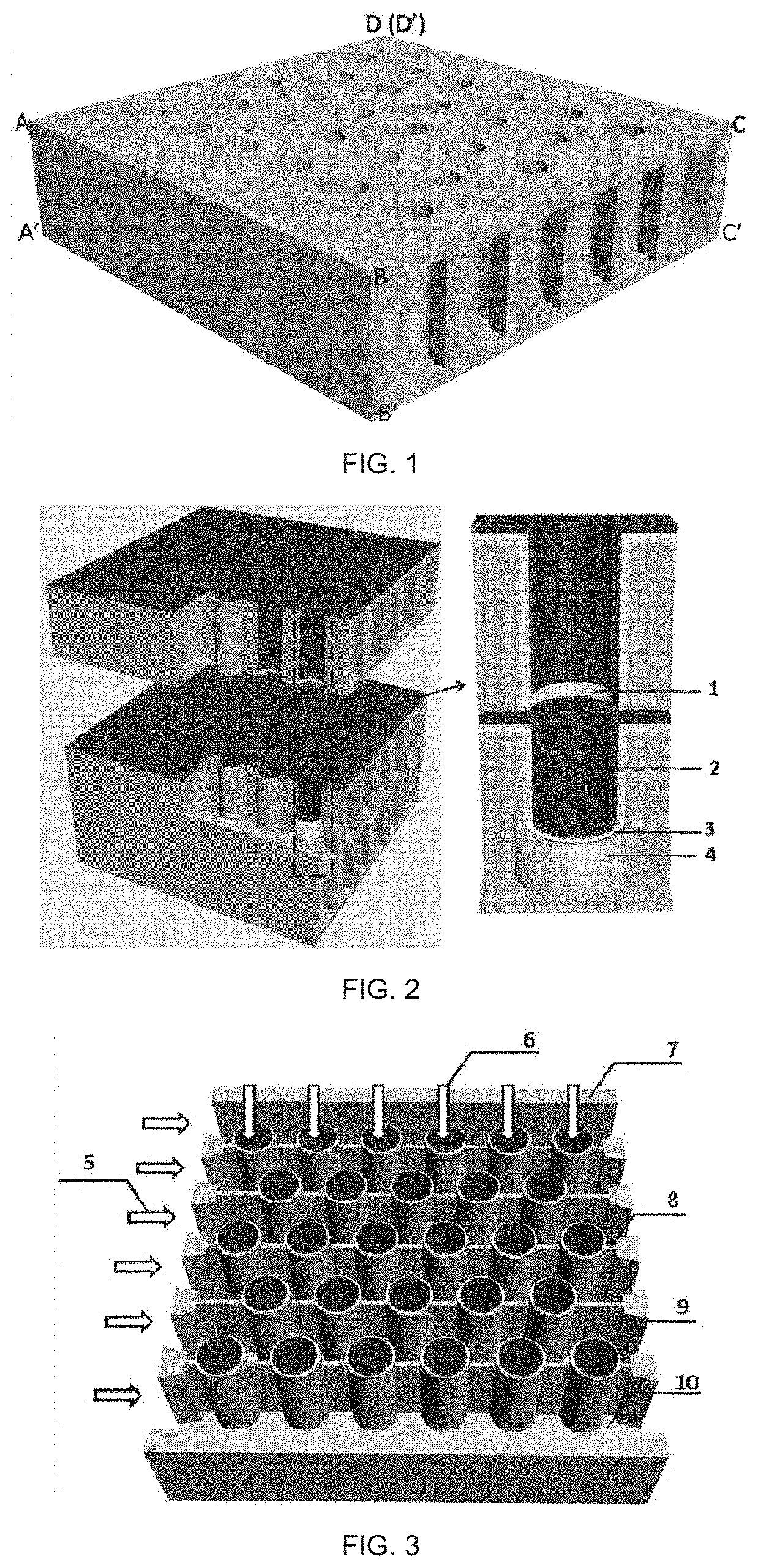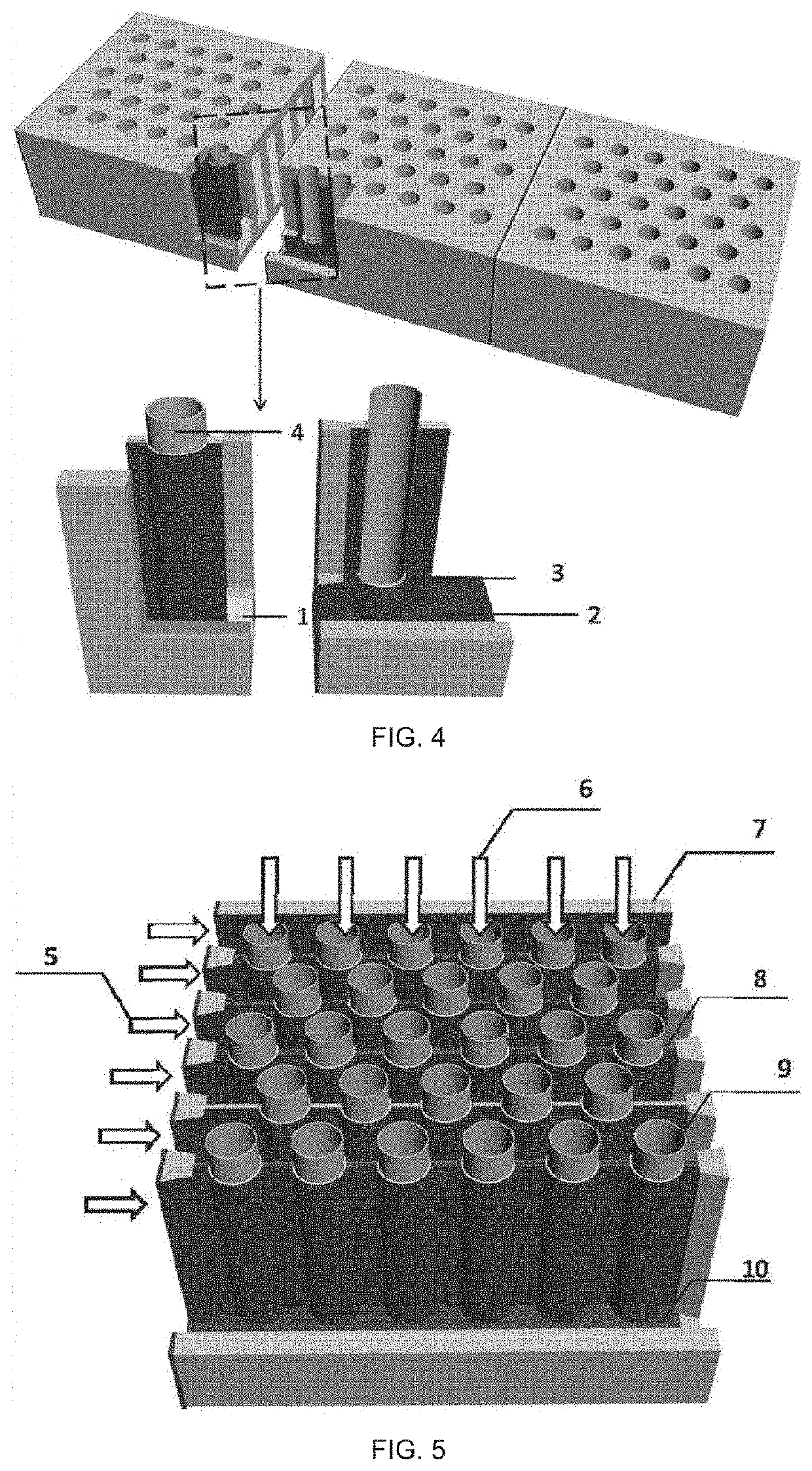Method for Preparing Connector-free Anode-supported Solid Oxide Fuel Cell Stack by Means of 3D Printing
- Summary
- Abstract
- Description
- Claims
- Application Information
AI Technical Summary
Benefits of technology
Problems solved by technology
Method used
Image
Examples
embodiment 1
[0056]100 g Ni−GDC (Gd0.1Ce0.9O2−δ) anode ceramic powder body (with a particle size of 800 nm) is mixed with a photosensitive resin and ethanol according to the proportion of 70 wt. % the powder body, 27.3 wt. % the photosensitive resin and 2.7 wt. % the ethanol, and the mixture is stirred and mixed for 12 h, and then ball-milled for 4 h to form a uniform paste. A model of a honeycomb-type anode-supported matrix with three-dimensional channels is established by utilizing Catia software, wherein the model is 2 cm in both length and width, and 1 cm in height, has 28 ceramic microtubes in a longitudinal direction to provide intratubal fluid channels, and 6 channels in a transverse direction to provide inter-tube fluid channels, referring to FIG. 1 for a structural schematic diagram thereof, and the model is led into CreationWorkshop software for slicing and printing. An AOTOCERA ceramic 3D printer of Beijing Ten Dimensions Technology Co. Ltd. is used as the 3D printer. The paste is add...
embodiment 2
[0061]70 g Ni—YSZ (Y0.08Zr0.92O2−δ) anode ceramic powder body (with a particle size of 500 nm) is uniformly mixed with 7 g starch by a mixer. 70 wt. % the powder body, 27.3 wt. % a photosensitive resin, 1.4 wt. % ethanol and 1.3 wt. % PEG are stirred and mixed for 12 h, and then ball-milled for 4 h to form a uniform paste. A model of a honeycomb-type anode-supported matrix with three-dimensional channels is established by utilizing UG software, wherein the model is 2 cm in both length and width, and 1 cm in height, has 28 ceramic microtubes in a longitudinal direction to provide intratubal fluid channels, and 6 channels in a transverse direction to provide inter-tube fluid channels, referring to FIG. 1 for a structural schematic diagram thereof, and the model is led into CreationWorkshop software for slicing and printing. An AOTOCERA ceramic 3D printer of Beijing Ten Dimensions Technology Co. Ltd. is used as the 3D printer. The paste is added into a resin tank, and the three-dimensi...
embodiment 3
[0065]70 g Ni-SDC (Sm0.2Ce0.8O2−δ) anode ceramic powder body (with a particle size of 500 nm) is uniformly mixed with 7 g starch by a mixer. 70 wt. % the powder body, and 30 wt. % a photosensitive resin are stirred and mixed for 20 h, and then ball-milled for 2 h to form a uniform paste. A model of a honeycomb-type anode-supported matrix with three-dimensional channels is established by utilizing 3DMax software, wherein the model is 2 cm in both length and width, and 1 cm in height, has 28 ceramic microtubes in a longitudinal direction to provide intratubal fluid channels, and 6 channels in a transverse direction to provide inter-tube fluid channels, referring to FIG. 1 for a structural schematic diagram thereof, and the model is led into CreationWorkshop software for slicing and printing. An AOTOCERA ceramic 3D printer of Beijing Ten Dimensions Technology Co. Ltd. is used as the 3D printer. The paste is added into a resin tank, and the three-dimensional printer is controlled by a c...
PUM
| Property | Measurement | Unit |
|---|---|---|
| Temperature | aaaaa | aaaaa |
| Temperature | aaaaa | aaaaa |
| Length | aaaaa | aaaaa |
Abstract
Description
Claims
Application Information
 Login to View More
Login to View More - Generate Ideas
- Intellectual Property
- Life Sciences
- Materials
- Tech Scout
- Unparalleled Data Quality
- Higher Quality Content
- 60% Fewer Hallucinations
Browse by: Latest US Patents, China's latest patents, Technical Efficacy Thesaurus, Application Domain, Technology Topic, Popular Technical Reports.
© 2025 PatSnap. All rights reserved.Legal|Privacy policy|Modern Slavery Act Transparency Statement|Sitemap|About US| Contact US: help@patsnap.com


